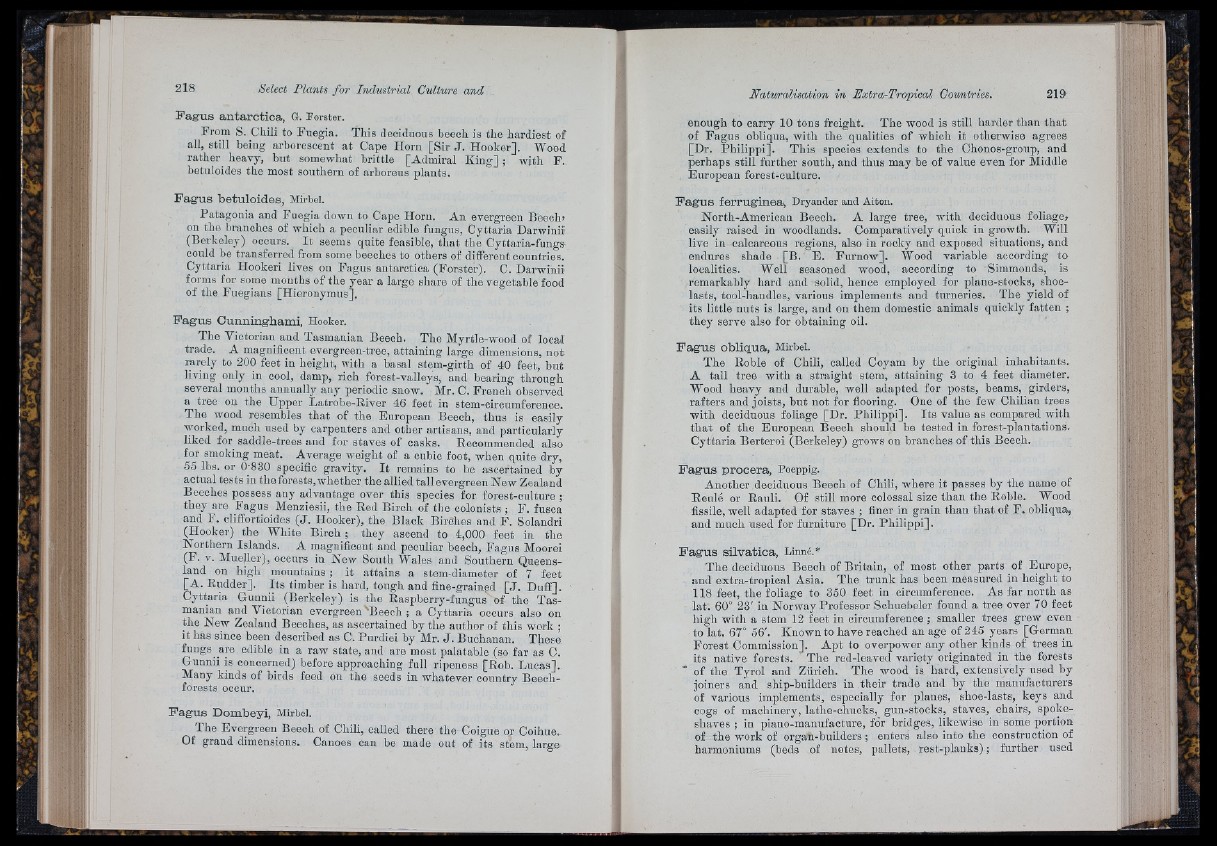
!
/■ [h
■ii
Select Plants fo r Industrial Culture and
P a g -u s a n t á r c t i c a , 6. Forster.
From S. Chili to Fnegia. This deciduous beech is the hardiest of
all, still being arborescent a t Cape Horn [Sir J . Hooker]. Wood
rather heavy, but somewhat brittle [Admiral King] ; with F.-
betuloides the most southern of arboreus plants.
P a g u s b e tu lo id e s , Mirbel.
Patagonia and Fuegia down to Cape Horn. An evergreen Beech>
on tbe branches of which a peculiar edible fnugns, Cyttaria Darwinii
(Berkeley) occurs. I t seems quite feasible, th a t'th e Cyttaria-fungs
could be transferred from some beeches to others of different countries.
Cyttaria Hookeri lives on Fagus antárctica (Forster). C. Darwinii
forms for some months of the year a large share of the vegetable food
of the Fuegiaus [Hieronymus].
P a g u s C u n n in g h am i, Hooker.
The Victorian aud Tasmanian Beech. The Myrtle-wood of local'
trade. A magnificent evergreen-tree, attaining large dimensions, not
rarely to 200 feet in height, with a basal stem-girth of 40 feet, but
living only in cool, damp, rich forest-valleys, and bearing through
several months anunally any periodic snow. Mr. C. French observed
a tree on tbe Upper Latrobe-River 46 feet in stem-circumference.
The wood resembles th a t of the European Beech, thus is easily
worked, much used by carpenters and other artisans, and particularly
liked for saddle-trees and for staves of casks. Recommended also
for smoking meat. Average weight of a cubic foot, when quite dry,
55 lbs. or 0-830 specific gravity. I t remains to be ascertained by
actual tests in the forests, whether the allied tallevergreen N ew Zealand
Beeches possess any advantage over this species for forest-culture ;
they are Fagus Menziesii, the Red Birch of the colonists ; F. fusca
and F. cliffortioides (J . Hooker), the Black Birches and F . Solandri
(Hooker) the White Birch ; they ascend to 4,000 feet in the
Northern Islands. A magnificent and peculiar beech, Fagus Moorei
(F. V. Mueller), occurs in New South Wales and Southern Queensland
on high mountains ; it attains a stem-diameter of 7 feet
[A . Rudder]. Its timber is hard, tough and fine-graingd [ J . Duff]. '
Cyttaria Gunnii (Berkeley) is the Raspberry-fungus of the Tasmanian
and Victorian evergreen 'Beech ; a Cyttaria occurs also on
the New Zealand Beeches, as ascertained by the author of this work ;
it has since been described as C. Purdiei by Mr. J . Buchanan. These
fungs are edible in a raw state, and are most palatable (so far as C.
Gunnii is concerned) before approaching full ripeness [Rob. Lucas].
Many kinds of birds feed on the seeds iu whatever country Beecli-
forests occur.
P a g u s D om b e y i, Mirbel.
The Evergreen Beech of Chili, called there the Coigue or Coihue.
Of grand dimensions. Canoes can be made out of its stem, large
enough to carry 10 tons freight. The wood is still harder than th a t
of Fagus obliqua, with the qualities of which it otherwise agrees
[Dr. Philippi]. This species extends to the Chonos-group, and
perhaps still further south, and thus may be of value even for Middle
European forest-culture.
Pagus ferruginea, Dryander and Aiton.
North-American Beech. A large tree, with deciduous foliage»
easily raised in woodlands. Comparatively quick in growth. Will
live in calcareous regions, also in rooky and exposed situations, and
endures shade [B. E. Furnow]. Wood variable according to
localities. Well seasoned wood, according to Simmonds, is
remarkably hard aud solid, hence employed for plane-stock», shoe-
lasts, tool-handles, various implements and turneries. The yield of
its little nuts is large, and on them domestic animals quickly fatten ;
they serve also for obtaining oil.
P agus obliqua, Mirbel.
The Roble of Chili, called Coyam by the original inhabitants.
A tall tree with a straight stem, attaining 3 to 4 feet diameter.
Wood heavy and durable, well adapted for posts, beams, girders,
rafters and joists, but not for flooring. One of the few Chilian trees
with deciduous foliage [Dr. Philippi]. Its value as compared with
th a t of the European Beech should be tested in forest-plantations.
Cyttaria Berteroi (Berkeley) grows on branches of this Beech.
Pagus prooera, Poeppig.
Another deciduous Beech of Chili, where it passes by the name of
Reule or Eauli. Of still more colossal size than the Roble. Wood
fissile, well adapted for staves ; finer in grain than th a t of F. obliqua,
and much used for furniture [Dr. P h ilip p i].
Pagus silvática, Linné.*
The deciduous Beech of Britain, of most other parts of Europe,
and extra-tropical Asia. The trunk has been measured in height to
118 feet, the foliage to 350 feet in circumference. As far north as
lat. 60° 23' in Norway Professor Schuebeler found a tree over 70 feet
high with a stem 12 feet in circumference ; smaller trees grew even
to lat. 67° 56'. Known to have reached an age of 245 years [German
Forest Commission]. Apt to overpower any other kinds of trees in
its native forests. The red-leaved variety originated in the forests
* of the Tyrol and Zurich. The wood is hard, extensively used by
joiners and ship-builders in their trade aud by the manufacturers
of various implements, especially for planes, shoe-lasts, keys and
cogs of machinery, lathe-chuoks, gun-stocks, staves, chairs, spoke-
sliaves ; in piano-manufacture, for bridges, likewise iu some portion
of the work of organ-builders; enters also into the construction of
harmoniums (beds of notes, pallets, rest-planks); further used
i f v: .